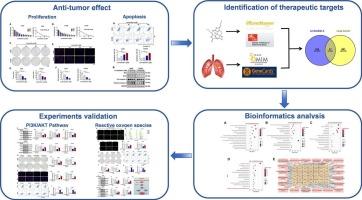Exploring the mechanism of Levistolide A in the treatment of lung cancer cells based on network analysis, molecular docking and experimental validation
IF 4.7
2区 医学
Q1 BIOCHEMISTRY & MOLECULAR BIOLOGY
引用次数: 0
Abstract
Levistolide A (LA) is the main active ingredient in the Angelica sinensis (Oliv.) Diels, which has been proved to have therapeutic effects on a variety of tumors, but its role in treating lung cancer remains unreported. In this study, we found that LA can inhibit lung cancer cell lines (A549 and H1299) proliferation and induced apoptosis via CCK-8, plate cloning, EdU labeling, flow cytometry and western blotting assay. Then, network analysis was performed to elucidate the molecular mechanisms of LA in treating lung cancer, we screened and obtained 57 common targets and 14 core targets for LA treatment of lung cancer by PharmMapper, Swiss Target Prediction, GeneCards and OMIM databases. Molecular docking studies demonstrated strong binding of LA to the core targets. KEGG analysis highlighted involvement in “pathways in cancer” and PI3K/AKT signaling. LA increased intracellular ROS levels, which inactivated PI3K/AKT, resulting in apoptosis and growth inhibition via experimental verification. In addition, 740Y![]() P (a PI3K/AKT pathway activator) and NAC (a ROS scavenger) were able to reverse the effects of LA on PI3K/AKT pathway, proliferation and apoptosis in lung cancer cells. In conclusion, these findings highlight the potential of LA as a promising anti-lung cancer agent and provide a foundation for further investigation into its clinical applications.
P (a PI3K/AKT pathway activator) and NAC (a ROS scavenger) were able to reverse the effects of LA on PI3K/AKT pathway, proliferation and apoptosis in lung cancer cells. In conclusion, these findings highlight the potential of LA as a promising anti-lung cancer agent and provide a foundation for further investigation into its clinical applications.

基于网络分析、分子对接和实验验证,探索列维stolide A治疗肺癌细胞的机制
列维stolide A (LA)是当归(Angelica sinensis)的主要活性成分。Diels,已被证明对多种肿瘤有治疗作用,但其在治疗肺癌中的作用尚未报道。本研究通过CCK-8、平板克隆、EdU标记、流式细胞术和western blotting等实验,发现LA能够抑制肺癌细胞株A549和H1299的增殖并诱导细胞凋亡。然后进行网络分析,阐明LA治疗肺癌的分子机制,通过PharmMapper、Swiss Target Prediction、GeneCards和OMIM数据库筛选得到LA治疗肺癌的57个常见靶点和14个核心靶点。分子对接研究表明LA与核心靶点有很强的结合。KEGG分析强调了“癌症通路”和PI3K/AKT信号通路的参与。经实验验证,LA增加细胞内ROS水平,使PI3K/AKT失活,导致细胞凋亡和生长抑制。此外,740YP(一种PI3K/AKT通路激活剂)和NAC(一种ROS清除剂)能够逆转LA对肺癌细胞PI3K/AKT通路、增殖和凋亡的影响。总之,这些发现突出了LA作为一种有前景的抗肺癌药物的潜力,并为进一步研究其临床应用奠定了基础。
本文章由计算机程序翻译,如有差异,请以英文原文为准。
求助全文
约1分钟内获得全文
求助全文
来源期刊

Bioorganic Chemistry
生物-生化与分子生物学
CiteScore
9.70
自引率
3.90%
发文量
679
审稿时长
31 days
期刊介绍:
Bioorganic Chemistry publishes research that addresses biological questions at the molecular level, using organic chemistry and principles of physical organic chemistry. The scope of the journal covers a range of topics at the organic chemistry-biology interface, including: enzyme catalysis, biotransformation and enzyme inhibition; nucleic acids chemistry; medicinal chemistry; natural product chemistry, natural product synthesis and natural product biosynthesis; antimicrobial agents; lipid and peptide chemistry; biophysical chemistry; biological probes; bio-orthogonal chemistry and biomimetic chemistry.
For manuscripts dealing with synthetic bioactive compounds, the Journal requires that the molecular target of the compounds described must be known, and must be demonstrated experimentally in the manuscript. For studies involving natural products, if the molecular target is unknown, some data beyond simple cell-based toxicity studies to provide insight into the mechanism of action is required. Studies supported by molecular docking are welcome, but must be supported by experimental data. The Journal does not consider manuscripts that are purely theoretical or computational in nature.
The Journal publishes regular articles, short communications and reviews. Reviews are normally invited by Editors or Editorial Board members. Authors of unsolicited reviews should first contact an Editor or Editorial Board member to determine whether the proposed article is within the scope of the Journal.
 求助内容:
求助内容: 应助结果提醒方式:
应助结果提醒方式:


